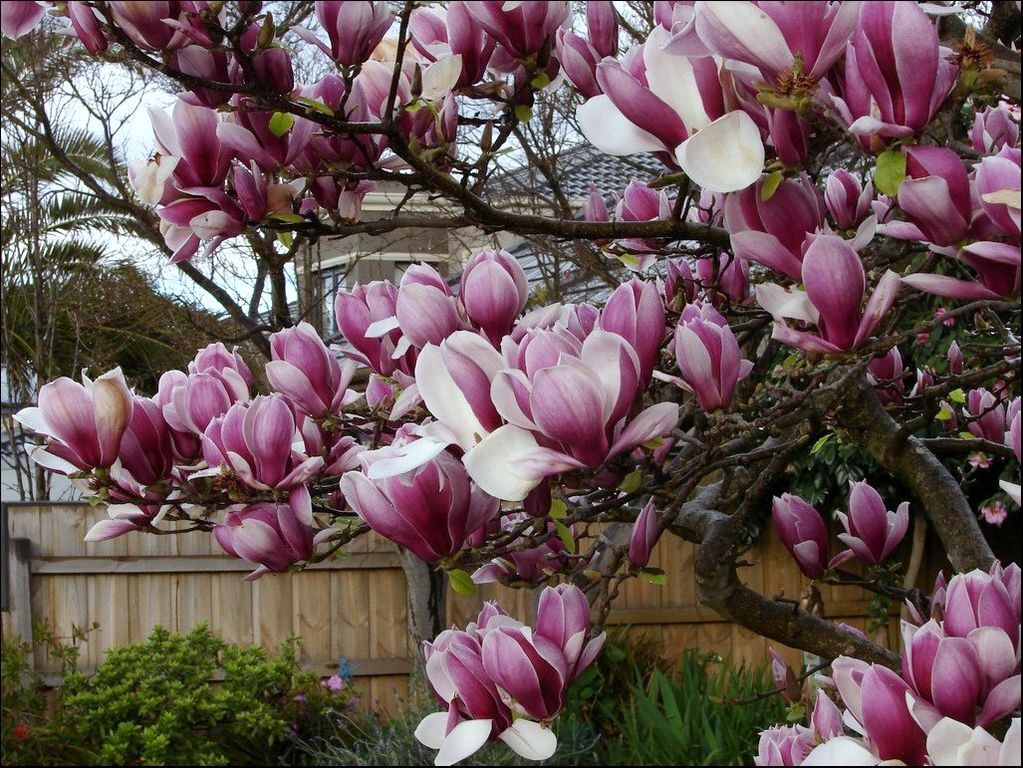This is the second half of a two part series on saucer magnolia cultivars.
Introduction
Saucer magnolia is a popular selection for cultivation. Numerous cultivars have been developed, and are available for purchase in nurseries and garden centers across the United States, Europe, and Canada. The cultivars are differentiated by their growth habit, leaf color, and flower color. The following examines some of the most frequently selected varieties, including ‘Lennei’, ‘Lennei Alba’, ‘Lilluputian’, ‘Rustica Rubra’, and ‘Verbanica’.
‘Lennei’: ‘Lennei’ magnolia is an older cultivar. It was first introduced in Europe in 1853. It is a large, spreading shrub that grows 15 to 25 feet tall, and 15 to 25 feet wide. An abundance of fragrant flowers bloom in early spring, prior to leaf expansion. The flowers are large, and goblet-shaped. They are colored deep purple, with white interiors. On new growth, flowers may continue to blossom into summer. These flowers tend to be less vigorous, and paler in tone. Medium green leaves emerge in spring. The leaves are ovate, and feature pointed tips. In fall, the leaves may turn yellow or bronze before dropping from the tree.
‘Lennei Alba’: ‘Lennei Alba’ magnolia is one of the most popular cultivars of saucer magnolia. It is a large shrub with a medium growth rate. It reaches 15 to 20 feet in height, with a 10 to 15 foot spread. ‘Lennei Alba’ is renown for the profusion of white blooms it produces in spring. The flowers are entirely white. Upon their emergence, they establish a resplendent floral display. Medium to dark green leaves appear in spring. They are obovate, with pointed tips. Leaves transition to yellow or bronze in fall.
‘Lilluputian’: ‘Lilluputian’ is a multi-stemmed, spreading tree that develops at a slow rate. It reaches heights of 12 to 15 feet, with a 10 to 18 foot spread. ‘Lilluputian’ is upright when young, but becomes ovate to rounded when mature. ‘Lilluputian’ features attractive, bright gray bark. Large, fuzzy buds open from late winter to early spring, prior to leaf expansion. They reveal masses of small pink flowers that combine to form a magnificent floral display. In cooler regions, the flowers may be damaged by late frosts. Medium to dark green leaves emerge in spring. When fully grown, the leaves measure four to eight inches in length. They are oblong, with pointed tips. In fall, the leaves brighten to yellow before being shed.
‘Rustica Rubra’: ‘Rustica Rubra’ magnolia, also referred to as ‘Rubra’ or ‘Rustica’, is a large, broad spreading shrub that develops at a medium rate. It reaches 20 to 25 feet tall, with a 20 to 25 foot spread. ‘Rustica Rubra’ has an upright to rounded growth habit. Numerous large, goblet-shaped flowers appear in early spring. In cooler regions, the blooms are prone to frost damage. The flowers are deep violet and rose, with pale pink interiors. They exude a pleasant citrus aroma. Large, oval, gray-green leaves emerge in spring. In fall, the leaves turn bright shades of green or yellow.
‘Verbanica’: ‘Verbanica’ magnolia is a multi-stemmed, spreading tree that has a slow growth rate. It reaches heights of 10 to 15 feet, with a 10 to 15 foot spread. ‘Verbanica’ has bright gray bark that is appealing in winter landscapes. When developing, the tree has an upright growth habit. It becomes ovate to rounded as it matures. Large, fuzzy buds bloom from late winter to mid spring, producing a multitude of pinkish-white flowers. The flowers of ‘Verbanica’ exhibit an increased resistance to late spring frosts, though they may still incur significant frost damage. Oblong to obovate leaves appear in spring. When fully grown, they may reach 4 to 8 inches in length. Leaves are initially medium to dark green, but turn yellow in fall.
Photo courtesy of Tatiana Gerus, CC-by-2.0.


